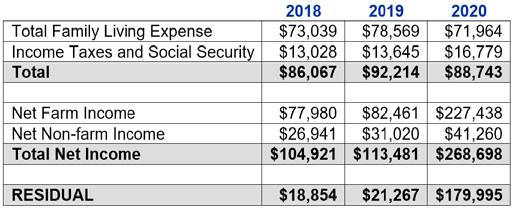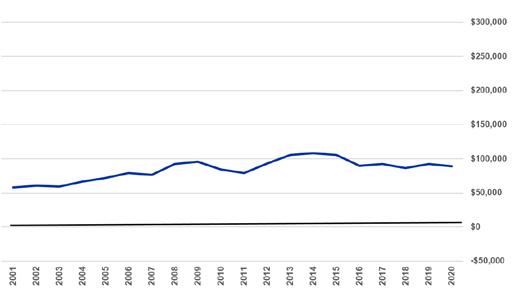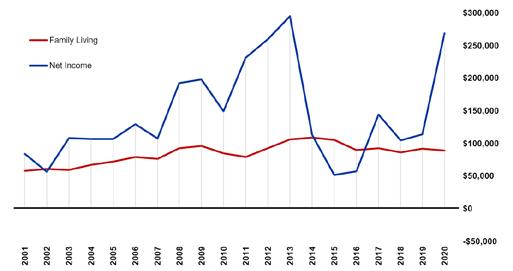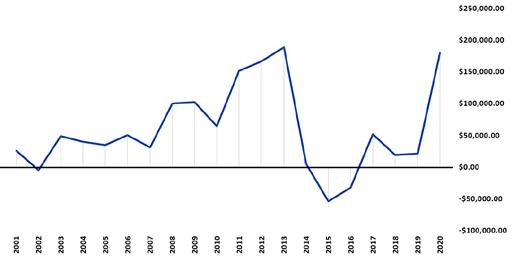
9 minute read
Economic & Policy Update
Family Living Expenses on Kentucky Farms
Steve Isaacs Contributing Writer
There is likely no single item in a farm business cash flow with more uncertainty and more variability than “family living expense.” Farm income and expense items are measured pretty accurately because they will be needed for tax reporting and for borrowing eligibility…two pretty good reasons. The difference in income and expenses is net farm income. Net farm income is what’s leftover to 1) pay debt, 2) grow the business, 3) pay taxes, and 4) live on. The last two are “family living.” We tend to live on what’s leftover after paying debt and taxes. That “leftover” spending may or may not be tracked with much accuracy. Thus, when someone asks, “What’s family living expense for a farm family?” we tend to answer with, “It’s hard to say, but here’s an average.” 2020 Results The Kentucky Farm Business Management program does have accurate family living data for some of the farms in their records and management program. The average family living expense for 168 farms in 2020 was $88,743. That breaks down to $71,964 for living expenses and $16,779 for income and social security taxes on the net farm income. Data from 2020 and the two previous years are presented in Table 1. The net income from farm and nonfarm sources to cover those expenses are also indicated in Table 1 with the residual difference being what is then left for debt payment and growth. Family living expense is a catch-all term that includes a number of items. The $71,964 average in 2020 is the sum of several categories that break out as follows. CONTRIBUTIONS: $5,552, MEDICAL: $7,875, LIFE INSURANCE: $4,500, EXPENDABLES: $50,591, and CAPITAL ITEMS: $3,445. While the $71,964 of living expenses in 2020 is an average of 168 farms, there is considerable variation in family living expenses. When ranked by family living expense into three categories, the 55 farms in the high one-third category spent an average of $131,970 while the low one-third category spent only $11,032. As odd as it seems the monthly expenditures of the high one-third is about equal to the annual expenses of the low one-third. Indeed, for family living expenses, “It’s hard to say.” The Long View Family living expenses and farm income and expense data have been collected in the KFBM program for decades. The following graphics are a visual representation of the totals in Table 1, but extended over a twenty-year period. The relatively stable but generally increasing line in Figure 1 would indicate that the average family living expense (including income taxes and social security) has been in the $60 to $100 thousand range. There is no such stability in net income (farm and non-farm combined). Adding the net income data in Figure 2 suggests what we already know…farm income has been highly variable over the past twenty years. In the peak years net farm income exceeded $200 thousand and the low years were in the $20 thousand range. Net non-farm income tended to be in the $30-40 thousand range. The difference in these two lines in Figure 2 is the income remaining to retire debt (i.e. principal payments) and/or to grow the business with asset purchases. This “residual” is graphed in Figure 3. In eleven of the twenty years that residual was less than $50 thousand, and was negative in some years when net farm and non-farm income was not sufficient to cover family living. Those years can be particularly troublesome when money must be found from other sources, or borrowing has to increase, with nothing left to pay principle on debt. Farm income is highly variable. Family living expenses aren’t. While the data presented here from the Kentucky Farm Business Management program are averages, individual farms can vary considerably. An awareness of, and planning for, this variability is critical to the future of the farm…and the family..
Table 1. KFBM Farms' Residual Income (2018-2020)
The Agricultural Economics Department publishes the Economic and Policy Update towards the end of each month. Each issue features articles written by extension personnel within the department and other experts across the country. Topics will vary greatly but regularly include marketing, management, policy, natural resources, and rural development issues. If you would like to recieve this newsletter by email, please contact Kenny Burdine at kburdine@uky. edu. You can also view current and past issues online at
https://bit.ly/2PoHsZj
Co-editors: Kenny Burdine, Alison Davis, and Greg Halich

Figure 1. KFBM Family Living Expenses Including Income Taxes and Social Security

Figure 2. KFBM Family Living and Net Income (farm and non-farm)

Bookkeeping Tips for Multi-entity Operations
Suzy Martin Contributing Writer
There are multiple reasons a farming operation might separate its business into multiple entities. It might be for transition and estate purposes, liability reasons, tax issues, etc. Ideally, these kinds of decisions involve input from everyone that is part of the “team.” Meaning owners, the attorney, tax advisor, management, lender, heirs, etc. Basically, anyone that might be impacted by such decisions. If an operation is part of a program like Kentucky Farm Business Management, not only can they be advised about the pros and cons of multi-entity structures but can also be educated about the importance of following through with the changes new business structures bring. In other words, if a business decides to set up these entities they must also be willing to “dot the i’s and cross the t’s” to ensure the reasons for them are not invalidated. For example, let’s say a farming operation sets up a new entity for the semis and grain trailers. Their goal is to limit liability in case of an accident. That’s all well and good but to actually get the limited liability that is being sought, the business needs to function as a completely separate business. This means that all insurance, loans, titles, etc. need to be in the name of the trucking company. All of the drivers need to be employees of the business and are paid for the hours spent trucking. If you have employees that truck and farm you might even have to pay them from different companies based on the work they have done. A trucking business would not qualify for the agriculture exemption, so any wages paid to employees through the business are subject to unemployment taxes.
CONTINUED FROM PAGE 19
Non-agriculture businesses file a quarterly Form 941 to report federal payroll taxes versus an annual Form 943. Workman’s compensation insurance would also need to be purchased. The trucking business would need to charge the farming operation a fair and reasonable rate to truck the grain. The operations would need to ensure they don’t mix the expenses between the companies. Another common example is to have the land in one entity and the farming operation in another. Again, they need to operate as completely separate businesses. The land improvements, property taxes, land loan payments, etc. need to be paid out of the land company. Also, deeds need to have the appropriate verbiage to match. The farming operation would need to pay a fair and reasonable rent to the land company. This would also include any buildings on the property as they are usually part of the real estate. The Farm Service Agency (FSA) would need to be aware of the setup for their records. There are other bookkeeping issues in multi-entity operations. One is the transfer of money between the entities. When the money gets transferred the income or expense account used should mirror the account that was used in the corresponding entity. Continuing the example above, if the farming entity pays rent to the landowning entity then the transaction would be recorded as a rental expense in the former and rental income in the latter. If the companies are simply transferring money between accounts, then in both entities the transaction would need to be put in a non-taxable account. The bottom line is that you cannot call an item an expense in one company without claiming it as income in the other. All entities need to have their own set of records and their own checking account. Finally, the entity that secures the loan should be the entity that makes the loan payments. This is the time of year that clients will make decisions to change up their business structure in preparation for a January 1st starting date. If this is something you are thinking of doing it would be beneficial to talk to your team. It’s easier to start off right than to try to correct mistakes after the fact.
Savannah Columbia Contributing Writer
COVID-19 has impacted the lives of every resident in the Commonwealth of Kentucky. Many Kentuckians have dealt with school and workplace closures, supply chain malfunctions, and so, so much more over the past two years. Interestingly, a connection can be made between COVID-19 and Kentucky’s migrant and resident agricultural worker population. Kentucky is home to a multi-billiondollar agriculture industry which operates in part by the labor inputs of foreign-born residents and migrant or H2A workers. Kentucky is home to 196,618 foreign-born residents, making up 4.4% of Kentucky’s total population (Migration Policy Institute, 2019). Foreign-born residents include naturalized U.S. citizens, immigrants holding green cards, work visas, or student visas, and refugees. Of these 196.6K foreign-born residents, 3.1% work in the agriculture, forestry, fishing and hunting, and mining workforce sector (MPI, 2019). While the Migration Policy Institute assigned a value to the number of foreign-born workers in our industry, it is still an extremely hard number to quantify. However, Kentucky is one of the top 10 states of employment for H2A workers – approving 6,952 H2A workers in 2020 and 7,200 workers in 2021. With our state being dependent on the labor contribution of migrant and resident workers, there is a need for us to be aware of how COVID is impacting our labor force. Exposure risk for COVID-19 among agricultural workers can be higher than expected because many farm crews carpool or travel together and share sleeping quarters or communal areas which may be difficult to social distance in. Migrant workers also may not feel like they can take advantage of prevention tools, such as vaccines, due to a lack of accessibility and misinformation. However, many states have developed variations of farmworker safety programs to help mitigate the spread of COVID-19 among agriculture workers. These include screening procedures, guidelines to follow for quarantine, and vaccination and/ or testing incentives. Programs like these are important, especially for our state, as Kentucky is ranked 13th in agriculture worker deaths resulting from COVID-19 (for all ag workers, foreign and domestic). Purdue University recently published an interactive tool, Purdue’s Food and Ag Vulnerability Index, which gives us an idea of Kentucky’s food and agriculture worker population and how it has been affected by COVID-19. Kentucky has one of the highest worker populations in the country, estimated at around 269,300 foreign and domestic workers. Of these, there have been 31,391 and 1,236 worker cases and migrantspecific worker cases, respectively. Worker safety is of the utmost importance to keep our food supply chain steady and sustainable. The University of Kentucky Cooperative Extension Service has worked to provide producers with guidelines and suggestions on best health practices to combat COVID, in both English and Spanish. Likewise, the University of Florida Extension has developed a farmworker safety training program to educate farm labor supervisors on COVID-19 mitigation in the workplace. Ideally, efforts such as these can aid in maintaining a safe workplace for our agriculture labor force.










